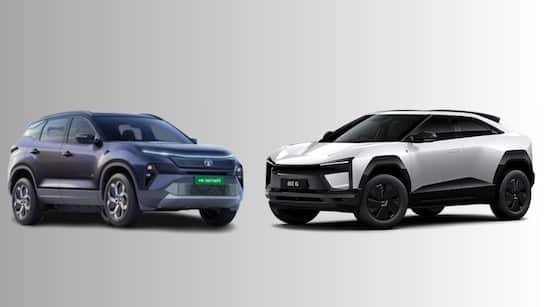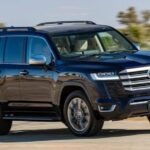Alright, let’s dive into the electric SUV showdown between two homegrown Indian heavyweights: the Tata Harrier.ev and the Mahindra BE 6. Both are vying for your attention in the rapidly growing electric vehicle market in India, and they bring some serious game. If you’re torn between these two, let’s break down their specs, features, and vibes to see which one might steal your heart (and wallet). Buckle up!

Price and Variants: Wallet Check
Tata Harrier.ev:
Starts at ₹21.49 lakh (ex-showroom) and goes up to ₹27.05 lakh for the top-spec variant. It’s available in four variants, with bookings opening on July 2, 2025.
Mahindra BE 6:
Kicks off at ₹18.90 lakh (ex-showroom) for the base Pack One (59 kWh battery) and climbs to ₹26.90 lakh for the top-spec Pack Three (79 kWh battery). It comes in five variants, with deliveries starting late February or early March 2025.Verdict: The Mahindra BE 6 is more affordable at the entry level, making it a tempting choice if you’re watching your budget. However, the Harrier.ev’s top-end pricing is competitive, especially with its all-wheel-drive (AWD) option. If you’re after premium features, the Tata might justify the extra spend.
Verdict:
The Mahindra BE 6 is more affordable at the entry level, making it a tempting choice if you’re watching your budget. However, the Harrier.ev’s top-end pricing is competitive, especially with its all-wheel-drive (AWD) option. If you’re after premium features, the Tata might justify the extra spend.
Design and Looks: Who’s Got the Swagger?
Tata Harrier.ev:
Sticks close to its diesel sibling’s bold, muscular design but adds EV flair with a sealed grille, aerodynamic alloy wheels, and a full-width LED light bar at the rear. It’s built on Tata’s Gen 2 Acti.EV Plus platform, giving it a familiar yet modern vibe. Think rugged yet refined, with a shark-fin antenna and a silver skid plate for that tough-SUV look.
Mahindra BE 6:
This one’s a head-turner with a sleek, coupe-SUV design on Mahindra’s INGLO platform. Its sloping roofline, sharp LED lights, and flush door handles scream futuristic. The closed front grille and sporty stance make it feel like it’s ready to race.
Verdict:
The Harrier.ev is the safe, classic SUV choice—perfect if you love that commanding road presence. The BE 6, with its coupe-like flair, feels fresher and more daring. It’s a matter of taste: traditional SUV or sporty trendsetter?
Powertrain and Performance: The Electric Punch
Tata Harrier.ev:
Battery: Offers 65 kWh and 75 kWh battery packs.
Power: Front motor (158 PS/116 kW) and rear motor (238 PS/175 kW), totaling up to 369 hp and 500 Nm in AWD setup.
Acceleration: 0-100 km/h in 6.3 seconds.
Range: Up to 627 km (ARAI claimed).
Charging: 1.5C fast charging delivers 250 km of range in 15 minutes; 20-80% in 25 minutes.
Drivetrain: Offers both rear-wheel-drive (RWD) and QWD (AWD) with off-road modes like Rock Crawl and Sand.
Mahindra BE 6:
Battery: 59 kWh (170 kW/228 hp) and 79 kWh (210 kW/281 hp) packs, both with 380 Nm torque.
Acceleration: 0-100 km/h in 6.7 seconds.
Range: 535 km (59 kWh) and 682 km (79 kWh, 550 km WLTP).
Charging: 175 kW DC fast charger takes the 79 kWh pack from 20-80% in 20 minutes.
Drivetrain: RWD only, with three modes (Range, Everyday, Race).
Verdict:
The Harrier.ev is the performance champ with more power (369 hp vs. 281 hp) and quicker acceleration. Its AWD option and off-road modes give it an edge for adventure enthusiasts. The BE 6, however, offers a longer claimed range with its 79 kWh pack and slightly faster charging. If outright power and off-road capability matter, the Tata leads; for range-focused daily driving, the Mahindra’s got a slight edge.
Features: Tech and Comfort Galore
Tata Harrier.ev:
Infotainment: Digital Video Recorder (DVR), wireless charger, air purifier, and a 540-degree surround view (including under-car view for off-roading).
Comfort: Dual-zone climate control, cooled storage, powered tailgate, panoramic sunroof, autonomous parking assist, and multiple regen modes with paddle shifters.
Unique Bits: Transparent Mode (shows terrain under the car), V2L/V2V charging, and a Stealth Edition at launch.
Mahindra BE 6:
Infotainment: Dual 12.3-inch displays, 16-speaker Harman Kardon system, wireless Android Auto/Apple CarPlay, and Dolby Atmos.
Comfort: One-touch single-pedal drive, 65W Type-C charging ports, connected car tech, and a frunk for extra storage.
Unique Bits: Digital key, ambient lighting, and exterior elements that “dance” to your tunes.
Verdict:
Both SUVs are loaded, but the Harrier.ev leans into off-road tech and practical features like V2L charging. The BE 6 feels more futuristic with its slick infotainment and driver-focused cockpit. If you want a techy, immersive cabin, the Mahindra’s your pick; for versatility, the Tata shines.
Safety: Who’s Got Your Back?
Tata Harrier.ev:
7 airbags (including a knee airbag), Electronic Stability Program (ESP) with i-VBAC, 20+ ADAS features (auto lane change, cross-traffic alert, etc.), all-wheel disc brakes, and an Acoustic Vehicle Alert System (AVAS).
Unique: SOS call function and transparent bonnet for off-road safety.
Mahindra BE 6:
6-7 airbags, 360-degree camera with blind spot monitor, driver drowsiness detection, rain-sensing wipers, TPMS, and L2 ADAS (auto park assist, cross-traffic alert).
Earned a 5-star Bharat NCAP rating.
Verdict:
Both are safety powerhouses, but the Harrier.ev’s extra airbag and off-road-focused features give it a slight edge for rugged use. The BE 6’s 5-star BNCAP rating and driver drowsiness detection make it a strong contender for urban safety.
Dimensions and Practicality: Space Race
Tata Harrier.ev:
Length: ~4,605 mm
Boot Space: 445 liters
Ground Clearance: Not specified, but likely similar to the ICE Harrier’s 205 mm.
Larger and taller, offering a roomier cabin for families.
Mahindra BE 6:
Length: 4,371 mm
Boot Space: 455 liters
Ground Clearance: 207 mm
Slightly smaller but with a frunk for extra storage.
Verdict:
The Harrier.ev is bigger, which might appeal to those needing more cabin space. The BE 6’s compact size and frunk make it more practical for city driving and small storage needs.
Which One’s Better?Choose the Tata Harrier.ev if:
You want a powerful, AWD-capable electric SUV with off-road chops and a familiar, muscular design. Its blistering 6.3-second 0-100 km/h sprint, 627 km range, and features like Transparent Mode make it ideal for those who want performance and adventure. The ₹21.49 lakh starting price is competitive for the tech and power on offer.
Choose the Mahindra BE 6 if:
You’re after a futuristic, sporty coupe-SUV with a sleek design and a tech-loaded cabin. Its 682 km range (79 kWh), fast charging, and 5-star BNCAP rating make it a great pick for urban drivers who want style and efficiency. The lower ₹18.90 lakh starting price is a big plus.
The Final Word
Both the Tata Harrier.ev and Mahindra BE 6 are stellar electric SUVs that showcase India’s growing EV prowess. The Harrier.ev feels like the muscle car of EVs—powerful, versatile, and ready for the wild. The BE 6, on the other hand, is the cool, tech-savvy kid on the block, with a design that screams “look at me!” Your choice boils down to what you value more: raw performance and off-road capability (Harrier.ev) or sleek design and urban practicality (BE 6). Either way, you’re getting a desi electric SUV that’s ready to take on the world. So, which one’s calling your name? Let me know.





